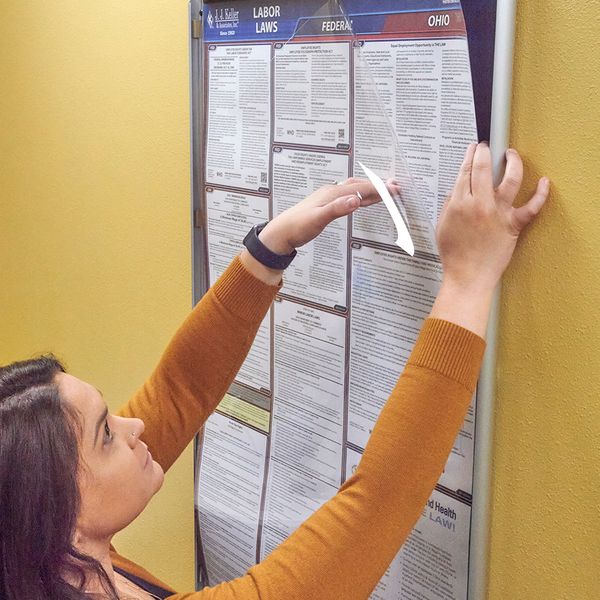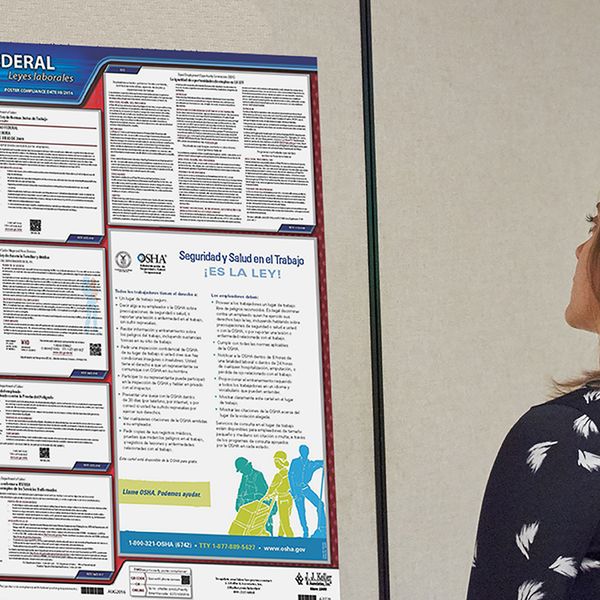Avoid higher fines — Your poster questions answered
Ignoring labor law posters just got more expensive: The Department of Labor increased fines for noncompliance, bringing the total potential fine to more than $42,000 per occurrence.
Compliance basically involves properly displaying required, current postings in a prominent place, but exactly how to do that can be surprisingly complex. Here are some posting questions we’ve received recently. The answers can help you avoid fines and the employee lawsuits that could result when posting compliance is overlooked:
Which posters do I need?
Employers need to display all federal, state, and local posters that apply to them. Most employers need these six federal postings:
- Fair Labor Standards Act
- Employee Polygraph Protection Act
- Job Safety and Health (Occupational Safety and Health Act)
- Uniformed Services Employment and Reemployment Rights Act (USERRA; may be posted or distributed via email)
- Know Your Rights: Workplace Discrimination is Illegal (required when an employer has 15 or more employees)
- Family and Medical Leave Act (required when an employer has 50 or more employees)
State posters relating to minimum wage, discrimination, workers’ compensation, unemployment insurance, and paid leave are also commonly required. In addition, when a city or county has its own minimum wage, a poster is likely needed.
What size do posters need to be?
All posters need to be readable. Shrinking them down to save space would not be compliant if the type size got so small that employees couldn’t tell what the posters said.
In addition, some posting regulations specify a size. For example:
- The federal OSHA Job Safety and Health posting must be 8 ½ by 14 inches. The type size must be at least 10 point, and the heading must be at least 36 points in size.
- The Colorado Notice to Employer of Injury posting needs to be at least 11 by 14 inches, and each letter must be half an inch high.
- New Jersey’s Family Leave Act posting must be at least 8 ½ by 11 inches.
When a posting regulation specifies a size, employers need to make sure the poster isn’t smaller than the law requires.
Is it better to place posters by an entrance or a break room?
Labor law posters must be placed in a conspicuous location where they are readily visible to employees.
Either a commonly used entrance or break room would be a good place to display posters. If employees use more than one entrance or break room (such as in a large building or on a corporate campus), then posters should be placed in multiple locations so all employees have the opportunity to view them.
Can we just put the posters online, or are physical posters required?
When a company has a physical workplace, electronic posters alone are not enough to meet posting regulations because they do not meet the requirement of being conspicuous and visible. In a field service bulletin addressing electronic posting, the Department of Labor (DOL) notes that, “In most cases, these electronic notices supplement but do not replace the statutory and regulatory requirements that employers post a hard-copy notice.”
Electronic postings meet posting requirements when all employees are remote. When an employer has a physical workplace, electronic posters are a great supplement but physical posters are still needed in the workplace.
What is the cost of noncompliance?
The DOL recently adjusted its fines for inflation. The penalties went up by about 3.2 percent and are:
- Family and Medical Leave Act: $211 for each separate offense
- Occupational Safety and Health Act: $16, 131 for each violation
- Employee Polygraph Protection Act: $25,597 for any violation of the law (including a posting violation)
The Equal Employment Opportunity Commission will also be increasing the fine for failure to display the Know Your Rights: Workplace Discrimination is Illegal posting, which lists employee rights under federal anti-discrimination laws. That fine is currently $659 and is expected to increase to about $680 when the agency’s fine increases are announced.
When all the potential maximum posting fines are added up, this brings the total maximum posting fine to an estimated $42,619.
Key to remember: While posting fines are typically only levied if an employer willfully and repeatedly violates the law, the fact that DOL adjusts them each year shows that the agency takes posting compliance seriously. Employers should make sure they are properly displaying all required postings.


































































